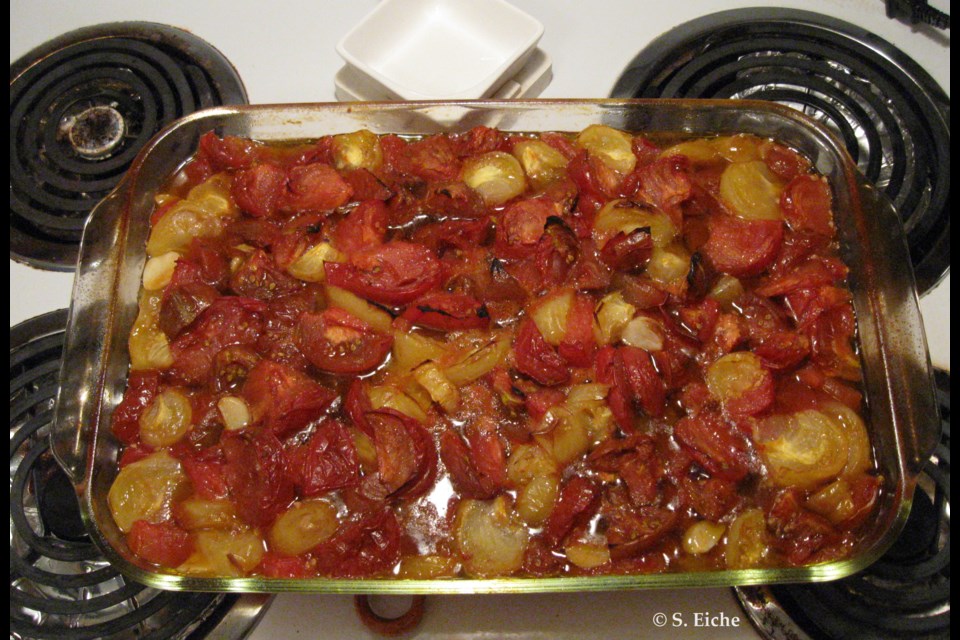If you’re in Italy and don’t like tomatoes you’ll end up being an extremely picky eater.
Tomatoes are everywhere. I can hardly imagine what Italian cooking was like before the Europeans brought the tomato from the Americas to the Old World in the early sixteenth century.
By 1548 there were tomato plants growing in Cosimo de’ Medici’s botanical garden in Pisa. Initially treated with suspicion, the tomato (called pomodoro, gold apple, in Italian) had to wait another century before it was accepted as a food.
Now there’s hardly any dish, except perhaps a sweet dessert, that can’t be combined with tomatoes, in one form or another.
A friend in California, who has tomatoes on her vines practically all year, makes a very special sauce for which she roasts the tomatoes. It’s easy and the result is fabulous.
I give you my version of her recipe.
In a bowl, you’ll cut up the tomatoes, large and small, perfect and flawed, ripe, overripe, not quite ripe, all mixed together, skins on, and toss them with extra virgin olive oil and kosher salt. Let stand for ten minutes or so.
Now take a large metal or Pyrex pan and in it place garlic cloves, as many as you want, and one or two sprigs of rosemary (give the leaves a couple of whacks with a kitchen mallet; no need to dispose of the stem at this point).
Pour the tomatoes out of the bowl into the pan, covering the garlic and rosemary. Place the pan in an oven heated to 400 degrees Fahrenheit and roast until the tomato skins show the first signs of turning black and everything is bubbling as if in a witches’ cauldron.
Take out the pan and let it cool off a bit. Finally, put the contents through a food mill. The skins, most of the seeds, and the rosemary stalks will all stay behind.
You’ll end up with a smooth sauce that you can pour into small glass jars and freeze.
When you heat it up to serve you can always add olives, capers and more garlic, or whatever you want.
In December I started making large batches of tomato sauce to share with a friend who loves Italian food. Because I didn’t want to use fresh tomatoes imported from Mexico or the southern US (most of them tasteless at this time of the year) I chose canned tomatoes.
It was the perfect opportunity to try out some of the many different brands.
At Stong’s on Dunbar, I bought three varieties of San Marzano dell’Agro Sarnese-Nocerino, the classic Italian tomato for cooking and baking (it grows in a relatively small area characterized by volcanic soil).
The San Remo brand of organic San Marzano was the most expensive, at $8.49 for a 796 ml can. The tomatoes were a disappointment, many were so hard I had to throw them away. The taste of the sauce was nothing to rave about.
Next, I tried Paese Mio, which the label called choice grade. It costs $6.99 for a 796 ml can. The tomatoes were good, and the resulting sauce was flavourful, a great combination of sweet and savoury.
The last one on my list had the Strianese label. Also, these tomatoes were good and the sauce as well, with a balance of sweet and savoury. The 796 ml can cost $6.99, but interestingly, the smaller 398 ml can (do the math, it’s half of 796) cost only $3.29, less than half of the large one.
There’s one surprise in this parade of canned tomatoes – the label is Unico, a Canadian brand established in 1917 (bought in 1973 by Sun-Brite, another Canadian firm).
In Unico’s wide range of tomatoes is one labelled “Product of Italy." It’s called “Diced Tomatoes Pezzettoni” and is available in a 398 ml can. I’ve found it only at Seafair’s Safeway, where it’s sold for $1.99.
The flavour is excellent and if you like your tomato sauce on the chunky side you don’t have to put this one through the food mill (which I did with the other varieties of canned tomatoes).
Olives (preferably pitted), garlic, capers and whatever else you want, are added to the sauce either in the final stages or when it’s reheated to be served.
One trick I learned from an Italian mama – add a bit of the cooked pasta water to the sauce before it joins the pasta.
Italy wasn’t the only country that encountered the New World tomato in the sixteenth century.
It also made its way to France where it was called the pomme d’amour, or love apple – so if you want to delight your Valentine with an unusual present next week, forget the predictable chocolates and offer them a tomato instead!
Sabine Eiche is a local writer and art historian with a PhD from Princeton University. Her passions are writing for children and protecting nature. Her columns deal with a broad range of topics and often include etymology in order to shed extra light on the subject.
📣 Got an opinion on this story or any others in Richmond? Send us a letter or email your thoughts or story tips to [email protected].
📲 To stay updated on Richmond news, sign up for our daily headline newsletter.
💬 Words missing in article? Your adblocker might be preventing hyperlinked text from appearing.



